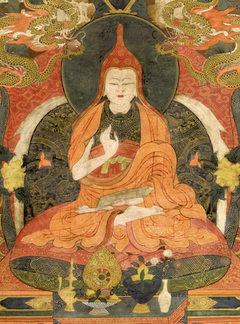Unifying the Two Accumulations
The Mirror of Essential Practice Instructions
Unifying the Two Accumulations
by Mipham Rinpoche
I prostrate to the deity of timeless knowing, the primordial buddha, Mañjughoṣa—in whom the enlightened mind of the victors of the three times is present, and whose form is the equalness of the indivisible nature of samsara and nirvana, the ultimate single sphere.
These days, some people practice the profound ultimate nature but only put effort into meditating on non-composite basic space, while dismissing composite positive actions and practices. Others grasp to the roots of virtue with concepts that solidify referential objects, while losing the meaning of non-referential pervasive openness. Neither understand the practice of unifying the two, which is why they are bound by clinging tightly to an extreme. This is because they have not realized the profound meaning of Dzogchen.
Although the actual true nature of reality is not a referential object, since all that appears is its ornamental display, these two—nature and appearance—do not obscure one another. And within the natural state of equalness and completeness, everything whatsoever is easeful.
Nevertheless, those who are new practitioners should temporarily lay aside making offerings, recitations, study, and so forth, which proliferate the stream of thoughts, and rest in innate naturalness, endeavoring to familiarize themselves with a naturally settled, naturally clear state.
For that purpose, the tantras instruct us to lay aside recitation, study, making offerings, and the like, and meditate on the pith instructions of profound meaning.
When the wide openness of the genuine nature, the radiance of awareness, emerges, just like the reflection of the moon on water, appearances do not obstruct it. At that time, whatever appears is its own ornamental display, in which the ocean of gathering accumulations of positive actions is effortlessly completed without purposeful deliberation. In such a case, the more effort one puts into making offerings, study, and so forth, the more this contributes to the emergence of the quintessence of profound meditation.
Whatever appears, good or bad, is not something to accept or reject—everything is equal as the ornamental display of the true nature of phenomena. Even if one were to seek “the darkness of harmful actions and suffering that arises from impure perceptions and delusion” it would be impossible to find.
From within the state of undeluded awareness, the uninterrupted ornaments—whatever appears and whatever one does—are the path to happiness and virtue. This happens naturally without striving.
Even as diligence toward relative positive actions blazes like a fire, meditation progresses. Even as meditation is as stable as a mountain, diligence toward relative positive action gains momentum. Both are a single nature, their essential points in harmony. Such is the outcome of the Dzogchen path.
When one attains the supreme indwelling confidence that all of samsara and nirvana are contained within self-knowing awareness, even without the external arrangement of a single flower, all possible appearances of existence are timelessly complete as spontaneously present offerings.
Similarly, for powerful yogins who have attained supreme indwelling confidence in sovereign equalness, the generation of the deity, recitations, mudrās, beneficial activities and so forth, are not sought after but are timelessly complete. This is beyond the limited perceptual domain of ordinary beings.
Practitioners training in the path of immersion in genuine being who have not reached such a level must still meditate by alternating the generation stage with elaborations and the completion stage without elaborations— the path of the two accumulations.
As they rely on the effortful path with referential objects, they should not abandon the certainty of knowing the meaning of the fundamental nature, which is beyond action and self-liberated. They should diligently engage in virtuous activities, not forsaking them but pursuing them according to their capacity.
While meditating with one-pointed focus on the ultimate nature of sovereign equalness, through leaving all appearances as they are, nothing obscures the basic space of phenomena; everything is recognized to be its ornamental display. Without stopping or producing, allow phenomena to rest in and of themselves within their own ground.
Therefore, for a practitioner immersed in awareness who recognizes the meaning of the ground of the indivisibility of the two truths, there is no conflict in alternating the training in the two accumulations according to one’s own experience. This is a crucial point to understand.
For practitioners who have reached the full and complete realization that all the paths encompassed by the two truths are not in conflict, no matter what they might do, their minds will be open and at ease. This is what is called the broad sky-like path of Dzogchen, the supreme vehicle.
Taking this as the basis, do not look down on composite roots of virtue, and be sure to supplement the cycles of Dzogchen transmissions with thorough explanations of how the two truths of the ground, the two accumulations of the path, and the two kāyas of the result are an indivisible unity.
Maṅgalam. This was written in the early evening by the light of a lamp on the 15th day of the first month of the Fire Horse year.[1]
| Translated by Paloma Lopez Landry based on the oral explanation of Khentrul Lodro Thaye Rinpoche, 2025.
Bibliography
Tibetan Edition
mi pham rgya mtsho. "tshogs gnyis zung 'jug gi nyams len gnad kyi me long" In gsung 'bum/_mi pham rgya mtsho. 32 vols. Chengdu: Gangs can rig gzhung dpe rnying myur skyobs lhan tshogs, 2007. (BDRC W2DB16631). Vol. 32: 515–518
Version: 1.0-20251111
-
10 March 1906. ↩
